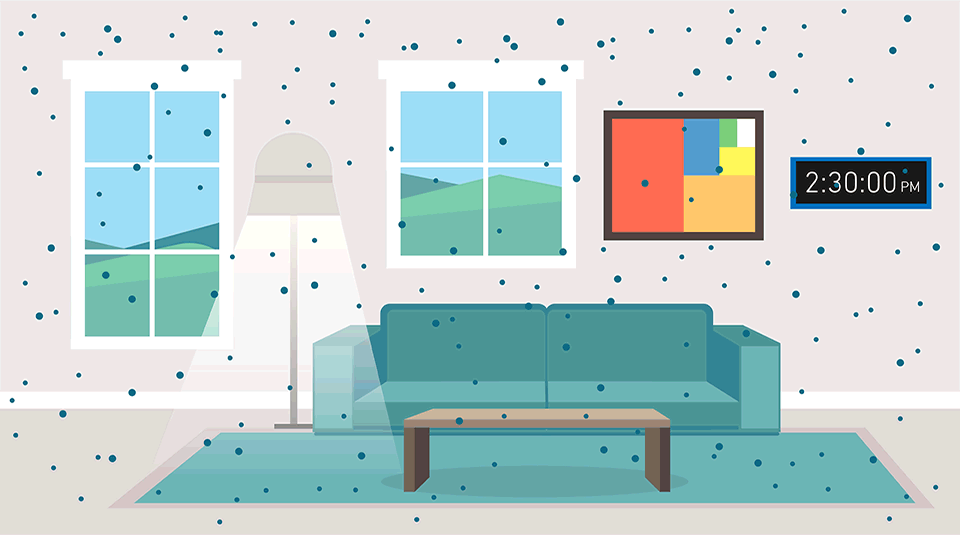
COVID-19 is still circulating in the U.S. and may once again gain traction as families and friends gather indoors over the holidays. There are several measures that, combined with vaccination, could curtail a new wave of infections. One often-overlooked approach for homes is managing air flow and air cleaning.
Leveraging ventilation and filtration has been an underutilized strategy for many residents throughout the pandemic because of the technical know-how required to implement these strategies. To help more people use this approach effectively, researchers at the National Institute of Standards and Technology (NIST) have developed a simple interactive webpage featuring the new Virus Particle Exposure in Residences (ViPER) tool. With ViPER — and some basic knowledge about their homes — homeowners and renters can learn how much certain actions, such as upgrading air filters or opening a window, may lower their risk of exposure to particles in the air that could potentially transmit COVID-19.
ViPER is based on an earlier tool developed in 2020 by NIST researchers with expertise in creating airflow and containment transport models. Called Fate and Transport of Indoor Microbiological Aerosols (FaTIMA), the web-based program estimates the concentration of exhaled aerosols — a collection of liquid and solids floating in the air, also often referred to as particles — a person would encounter in a single space.
Oftentimes, these particles are harmless, but in other instances, they can harbor pathogens, such as the virus that causes COVID-19. It is generally difficult to predict how many particles would be carrying a virus in a given scenario, but FaTIMA’s calculations cover all bases by describing exhaled particles whether or not they contain pathogens.
The tool’s specific purpose is to guide people in selecting strategies to reduce the number of airborne particles indoors in general, which could in turn mitigate COVID-19 transmission. However, it is mostly geared toward engineers, building managers and others familiar with heating, ventilating and air conditioning (HVAC) systems, as it requires users to provide a great deal of technical information about a space and its HVAC system.
The same NIST team, in collaboration with the Centers for Disease Control and Prevention (CDC) and with support from the CDC Foundation, a nonprofit organization, aimed to put together more streamlined tools based on data from FaTIMA that could be useful for the average resident.
“Even as a researcher it would take me a while to gather all the necessary information to run FaTIMA. But this tool is a lot easier to use,” said mechanical engineer Lisa Ng, a member of the NIST team. “You don’t need any information on hand except your house size and some basics about your HVAC, and you could potentially learn something to help you make better decisions.”
Ng and her colleagues ran nearly 1,300 simulations in FaTIMA, altering seven different variables. In addition to home size, they varied air filter efficiency (often appearing on products as a MERV rating), the use of portable air cleaners, the duration of a gathering and more. Each simulation produced a value representing the concentration of particles to which someone could be exposed.
These simulations formed the basis of ViPER, a NIST tool that allows users to explore the team’s results through seven drop-down menus, each related to a variable with some degree of influence over the number of particles in a home. The CDC also used the results to develop a separate, further streamlined interactive ventilation tool with even fewer user inputs.
By selecting the options under each menu in ViPER that most closely match their current scenario, users could establish what particle exposure could be in their home’s current state. From there, users could tweak their inputs in the menus and find out the degree to which different actions could reduce their exposure compared with their initial scenario.
Imagine an owner of a 1,000-square-foot house is hosting a four-hour holiday party, with all the windows closed and a MERV 6 filter installed in the HVAC system.
“A homeowner might find that upgrading their HVAC filter to a MERV 13 filter if possible, adding a portable HEPA air cleaner, or running their fan for an hour after their gathering could make an impact on their potential exposure,” Ng said. “There are many different things someone could learn depending on their situation.”
The new interactive tool is designed to provide pertinent information to residents and better equip them to take basic but important steps, be it adding a portable air cleaner or running an HVAC system fan for longer than typical.
An important consideration for users to keep in mind is that, at the moment, ViPER is still only able to approximate any home as a single space, and there are several other factors not yet accounted for in the tool, such as the exhaust-only ventilation provided by bathrooms and kitchen fans.
“While adequate for conveying general concepts, the tool’s calculations are not meant to be taken as a comprehensive assessment of COVID being transmitted in a home,” Ng said.
In the future, the researchers plan to expand their modeling capabilities, but for now, the interactive tool has been published on the NIST website to help residents prepare for the holidays.
The CDC’s interactive ventilation tool is also available, along with additional resources on improving home ventilation.

